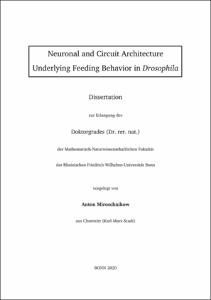Neuronal and Circuit Architecture Underlying Feeding Behavior in Drosophila

Neuronal and Circuit Architecture Underlying Feeding Behavior in Drosophila

| dc.contributor.advisor | Pankratz, Michael | |
| dc.contributor.author | Miroschnikow, Anton | |
| dc.date.accessioned | 2021-06-28T11:16:35Z | |
| dc.date.available | 2021-06-28T11:16:35Z | |
| dc.date.issued | 28.06.2021 | |
| dc.identifier.uri | https://hdl.handle.net/20.500.11811/9188 | |
| dc.description.abstract | Feeding is elemental for survival and one of the most common activities of animals. Little is known about the organization of neuronal circuits controlling feeding behavior in the cen-tral nervous system. This study maps, from a whole brain ssTEM volume, the connectivity of all input and output neurons that underlie food intake behavior of Drosophila larvae on synaptic level.
The input neurons originate from enteric, pharyngeal and external organs, project through the three pharyngeal nerves and converge, based on modality and peripheral origin, onto seven topographical distinct sensory synaptic compartments within the CNS. The output neurons consist of pharyngeal motor neuron, serotonergic modulatory neu-rons, and neuroendocrine neurons, that target the ring gland, a major endocrine organ of Drosophila. Strikingly, sensory neurons from three sensory compartments form a signifi-cant amount of monosynaptic connections to motor, modulatory and neuroendocrine tar-gets in overlapping domains and are distinct from those that form polysynaptic connec-tions to the mushroom body, a center of insect associative learning. An early convergence of olfactory and gustatory information is observed at the level of second order neurons connecting to the mushroom body calyx. Polysynaptic routes are superimposed on top of the monosynaptic connections, result-ing in a series of parallel divergent sensory pathways that converge onto common motor outputs. The majority of the premotor neurons constituting the different parallel paths integrate each slightly different and recurrently cross-modal sensory inputs. A set of mushroom body output neurons connects directly to these premotor neurons. These results propose a circuit architecture for feeding behavior in which monosynap-tic and multisynaptic pathways can be traversed from sensory inputs to output neurons via a series of converging paths, which has relevance for understanding the mechanisms of action selection. | en |
| dc.language.iso | eng | |
| dc.rights | In Copyright | |
| dc.rights.uri | http://rightsstatements.org/vocab/InC/1.0/ | |
| dc.subject | D. melanogaster | |
| dc.subject | feeding | |
| dc.subject | connectome | |
| dc.subject | sensory neurons | |
| dc.subject | motor neurons | |
| dc.subject | neuroscience | |
| dc.subject.ddc | 570 Biowissenschaften, Biologie | |
| dc.subject.ddc | 610 Medizin, Gesundheit | |
| dc.title | Neuronal and Circuit Architecture Underlying Feeding Behavior in Drosophila | |
| dc.type | Dissertation oder Habilitation | |
| dc.publisher.name | Universitäts- und Landesbibliothek Bonn | |
| dc.publisher.location | Bonn | |
| dc.rights.accessRights | openAccess | |
| dc.identifier.urn | https://nbn-resolving.org/urn:nbn:de:hbz:5-62816 | |
| ulbbn.pubtype | Erstveröffentlichung | |
| ulbbnediss.affiliation.name | Rheinische Friedrich-Wilhelms-Universität Bonn | |
| ulbbnediss.affiliation.location | Bonn | |
| ulbbnediss.thesis.level | Dissertation | |
| ulbbnediss.dissID | 6281 | |
| ulbbnediss.date.accepted | 18.06.2021 | |
| ulbbnediss.institute | Mathematisch-Naturwissenschaftliche Fakultät : Fachgruppe Molekulare Biomedizin / Life & Medical Sciences-Institut (LIMES) | |
| ulbbnediss.fakultaet | Mathematisch-Naturwissenschaftliche Fakultät | |
| dc.contributor.coReferee | Bauer, Reinhard | |
| ulbbnediss.contributor.orcid | https://orcid.org/0000-0002-2276-3434 | |
| ulbbnediss.contributor.gnd | 123804056X |
Dateien zu dieser Ressource
Das Dokument erscheint in:
-
E-Dissertationen (4077)




